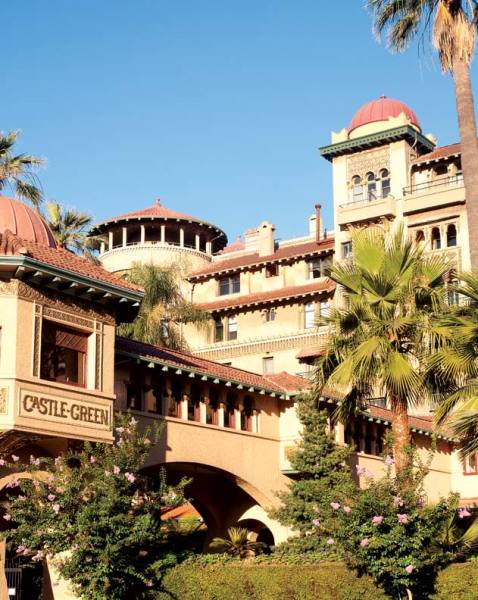
The eclectic Castle Green mixes Moorish, Spanish, and Victorian styles. (Photo: Magnus Stark)
With its mild climate and heady foliage, Pasadena has long enchanted visitors. Turn-of-the-century travel literature called the area “a Mediterranean wonderland,” and the mountain peaks, rising above the town, were said to evoke the Swiss Alps. A funicular railroad that took travelers to an “Alpine Tavern” advertised itself as connecting “Switzerland and Italy…From Roses and Orange Groves to Snow in Two Hours’ Time.”
Because this is Southern California, land of orange blossoms and freeways, a tour of the area can’t be done without a car. But only on foot will you understand the joy of Pasadena: the coolness beneath the tree-canopied streets; the sweet scent of roses blooming in bungalow front yards; the quiet, inventive artistry of Greene & Greene houses overlooking the Arroyo. Plan to park and walk: Pasadena needs to be experienced as it was a hundred years ago, before cars and freeways overtook our lives.
Old Pasadena
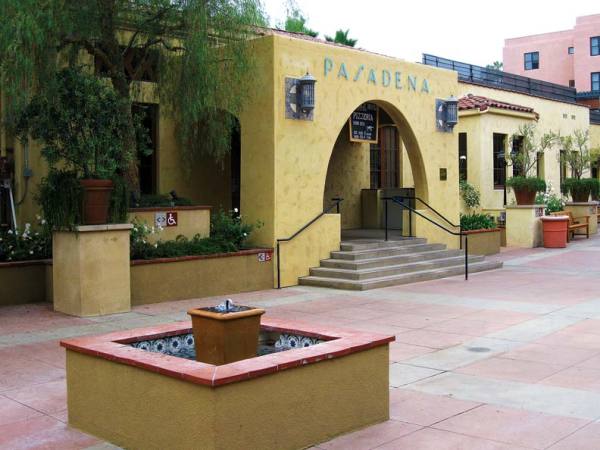
Once a hub for visitors to Southern California, the old Santa Fe train station now holds a café. (Photo:
Start at the old Santa Fe train station on South Raymond. The 1930s Spanish Colonial Revival building really speaks to what Southern California was about: the romance of the Missions, the exoticism early tourists found in the Mexican adobes. Stand in front of the former station and imagine what it was like arriving in the Southlands a hundred years ago, leaving Midwest snow and sleet behind to face the soft sunshine and swaying palm trees. The building is no longer a train station; the Santa Fe hasn’t come through Pasadena for two decades. Today it’s a restaurant, worth visiting not only for the food but also to see the original Batchelder tiles preserved there.
Stepping off the Super Chief back then, you’d go next door to the Hotel Green, a grand resort built in the Moorish and Mission Revival styles; think balconies, round towers, and turrets with onion-shaped domes. It was like arriving in a fantasyland. The hotel complex covered nearly two blocks of the city center.
Now called the Castle Green, the main hotel is long gone, but the 1898-built annex remains, converted to apartments and condos. Walk by it, past the “Bridge of Sighs” that once connected the annex to the main hotel, then continue to Colorado Boulevard and “Old Pasadena,” where most of the buildings date from around the turn of the last century. The façades are more modern, though, dating from 1929, when the street was widened and the original fronts replaced. It’s an incredible example of historic revitalization—and a lively, vibrant street scene.
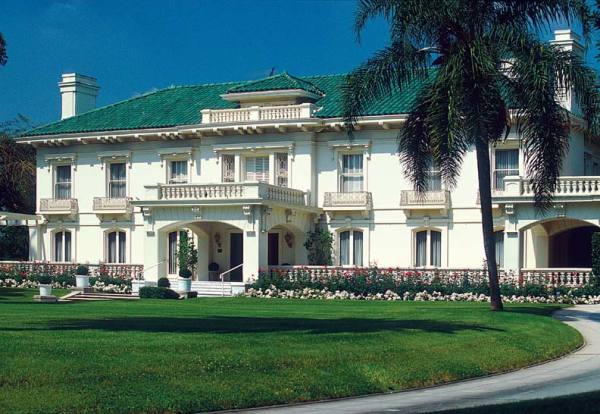
The Italian Renaissance-style Wrigley Mansion serves as headquarters for the Tournament of Roses. (Photo: Pasadena Convention & Visitors Bureau)
Little Switzerland
A century ago, you could catch the horse-drawn “Tally Ho Coach” to go sightseeing up the wide, tree-lined Orange Grove Boulevard (dubbed Millionaires’ Row), past the palatial wedding-cake mansions built by wealthy tourists who came to visit and ended up staying. The one great remaining example is the Italian Renaissance-style William Wrigley, Jr. Estate (built for the chewing gum magnate), all frothy and white and now the home of the Tournament of Roses.
The coach would continue to a nearby cluster of homes, called Little Switzerland, that were the antithesis of the Wrigley mansion. It was here on the edge of the Arroyo Seco, the ravine at Pasadena’s western border, that architect Charles Greene chose to build his home in 1902. Over the next six years, working with his brother Henry, he designed a dozen more. He consciously rejected the traditional revival styles, creating instead an architectural vocabulary inspired by Japanese timber-frame construction, the Swiss chalet, and the California casa de ranchero. The goal: to develop a singular style of architecture appropriate to California’s climate and lifestyle.
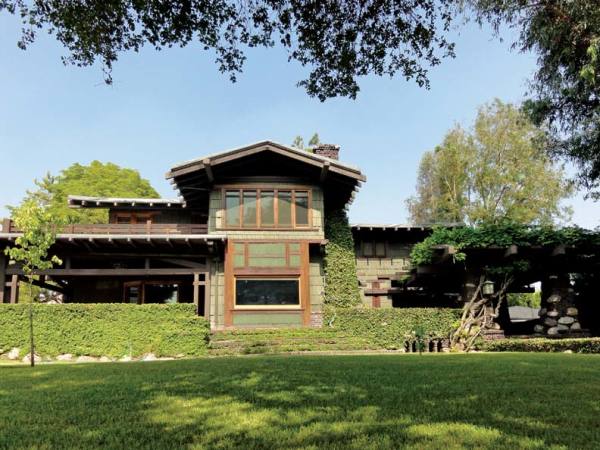
The Duncan-Irwin House, remodeled by Greene & Greene in 1906, displays all the hallmarks of the brothers’ iconic style. (Photo: Tom Stohlman)
Start your neighborhood stroll along Arroyo Terrace, just off Orange Grove. There you’ll find a string of eight houses, all designed by Greene & Greene. With the exception of the second house, which was drastically altered in 1927, you can see the elements of their stylistic vocabulary being tried out, often for the first time: massive pilings of Arroyo stone and clinker brick, Japonesque lanterns, verandas and pergolas, open courtyards and shaded porches, and low-pitched rooflines with rafter tails. The last house in this series, the Duncan-Irwin House, sited just where Arroyo Terrace meets up with Grand Avenue, is where the Greenes’ work finally found fruition with the unified style the brothers are known for today. This is the work that formed the basis for the architectural tour de forces just ahead in the their careers.
One block north of this neighborhood, you’ll find the prime example of a Greene & Greene masterwork, the David B. Gamble House, a National Trust Landmark. Built in 1908, it was delivered to the client complete with furniture, lighting, art glass, and carpets, all designed by the Greenes. It is meticulously preserved today as a complete work of art.
Bungalow Heaven
Pasadena was not all grand houses for wealthy tourists. As the city grew and Midwest migrants kept arriving by train—between 1900 and 1920, the city expanded fourfold—a new style of housing quickly went up: the bungalow. It was simple, casual, and intended for the spontaneous lifestyle of California. The mostly single-story homes had broad front porches and open floor plans with front doors opening right into the living room.
Blocks and blocks of bungalows were built close to the city center, before the automobile dictated the spread out into the suburbs. In one area, just northeast of downtown, more than 1,100 bungalows were constructed in those first few decades. Few of them were architect-designed; many came from plan books, and some were kit houses.
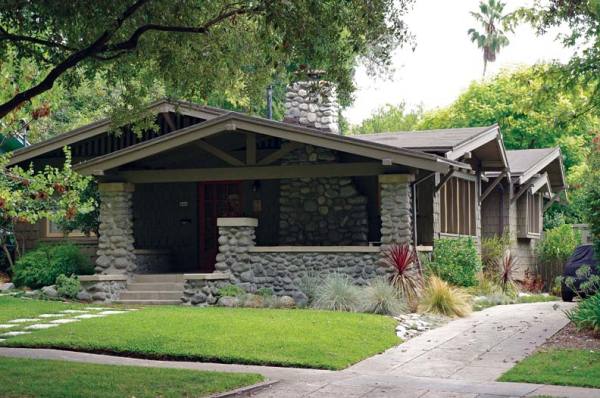
Designated a landmark district in 1989, the Bungalow Heaven neighborhood showcases one of the country’s largest collections of well-preserved bungalows. (Photo: David Alexander)
In the mid-1980s, as these out-of-date houses were being torn down, replaced with freeways or funky apartment buildings, a group of local homeowners realized what was being lost. They organized, and in 1989 succeeded in getting the neighborhood, dubbed “Bungalow Heaven,” designated as Pasadena’s first landmark district. In 2008, it earned a spot in the National Register of Historic Places.
Bungalow Heaven covers about a square mile—16 blocks in a grid going northeast from the corner of Orange Grove Blvd. and Lake Ave. Head right to the middle of it, park your car by McDonald Park, then get out and walk.
Strolling the sidewalks, you’ll see meticulously restored bungalows in a whole range of styles, from Japo-Swiss to Mission, from Colonial Revival to Craftsman. A number used stylistic tropes developed by the Greenes. The broad eave overhangs with rafter tails were especially copied, as were the cobblestone and clinker-brick front porches.
But it is the neighborhood you should be experiencing—the leafy trees overhanging the streets, children playing on front lawns, neighbors talking on the sidewalk. It embodies the lifestyle promoted by the bungalow, something evident in what is perhaps the finest gathering of bungalows in California. Considering that the California bungalow was developed here, you might call this Pasadena’s gift to the nation.
A resident of Washington state,Bruce Smithwas born in Pasadena. His grandparents were part of the migration from the Midwest, coming to Pasadena in the 1920s, and his parents grew up in Bungalow Heaven.
Online exclusive:See where to shop for old-house parts in Pasadena.







